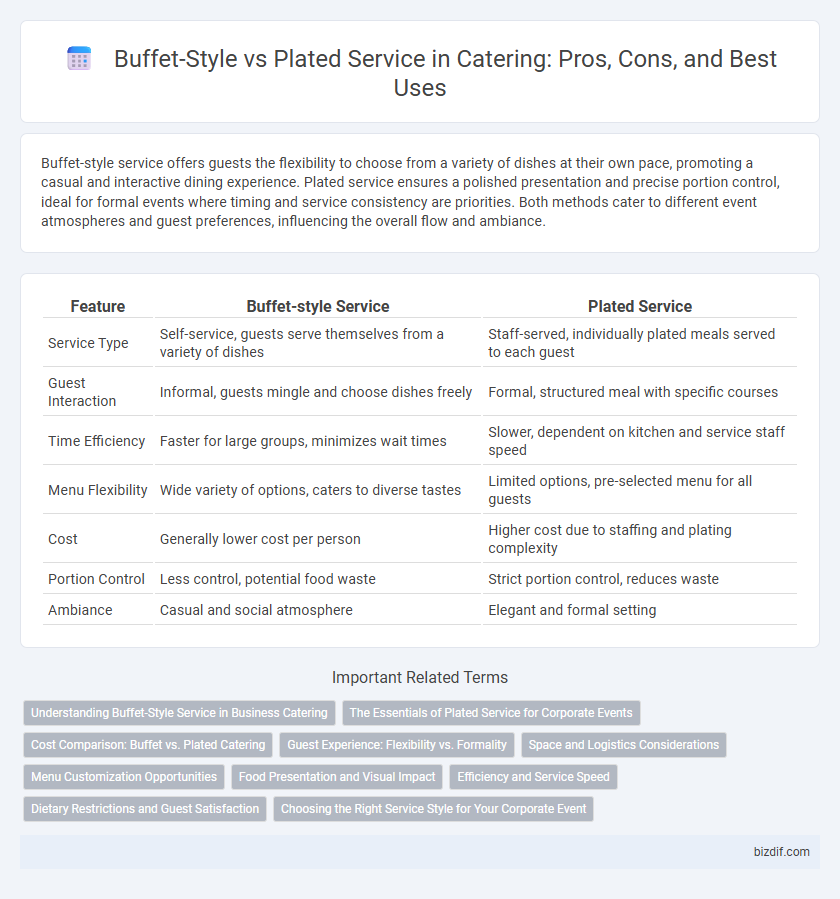Buffet-style service offers guests the flexibility to choose from a variety of dishes at their own pace, promoting a casual and interactive dining experience. Plated service ensures a polished presentation and precise portion control, ideal for formal events where timing and service consistency are priorities. Both methods cater to different event atmospheres and guest preferences, influencing the overall flow and ambiance.
Table of Comparison
| Feature | Buffet-style Service | Plated Service |
|---|---|---|
| Service Type | Self-service, guests serve themselves from a variety of dishes | Staff-served, individually plated meals served to each guest |
| Guest Interaction | Informal, guests mingle and choose dishes freely | Formal, structured meal with specific courses |
| Time Efficiency | Faster for large groups, minimizes wait times | Slower, dependent on kitchen and service staff speed |
| Menu Flexibility | Wide variety of options, caters to diverse tastes | Limited options, pre-selected menu for all guests |
| Cost | Generally lower cost per person | Higher cost due to staffing and plating complexity |
| Portion Control | Less control, potential food waste | Strict portion control, reduces waste |
| Ambiance | Casual and social atmosphere | Elegant and formal setting |
Understanding Buffet-Style Service in Business Catering
Buffet-style service in business catering offers a flexible dining experience where guests serve themselves from a variety of dishes, enabling efficient food distribution during large events or meetings. This service style reduces the need for extensive waitstaff, allowing for cost-effective operations and faster turnover without compromising on menu variety or presentation. By facilitating networking and interaction among attendees, buffet-style catering supports a dynamic business environment while accommodating diverse dietary preferences.
The Essentials of Plated Service for Corporate Events
Plated service in corporate events ensures a tailored dining experience where each guest receives a carefully portioned meal, enhancing presentation and professionalism. This service style allows precise control over menu choices, dietary restrictions, and timing, critical for maintaining event flow and guest satisfaction. Efficiency in plated service also minimizes food waste and elevates the overall guest experience through attentive, individualized attention.
Cost Comparison: Buffet vs. Plated Catering
Buffet-style catering generally reduces overall costs by minimizing required servers and allowing guests to serve themselves, lowering labor expenses compared to plated service. Plated catering demands more staff for individual meal preparation and delivery, increasing labor and service costs significantly. Food waste can be less controllable in buffets, but portioning in plated service often leads to higher food costs per guest.
Guest Experience: Flexibility vs. Formality
Buffet-style service offers guests the flexibility to choose from a variety of dishes and customize their portions, enhancing interaction and informal socializing. Plated service, with its structured presentation and course timing, creates a more formal and refined dining experience, emphasizing elegance and order. Both approaches impact guest experience by balancing personalization with sophistication, depending on the event's atmosphere and expectations.
Space and Logistics Considerations
Buffet-style service maximizes space efficiency by centralizing food stations, allowing guests to serve themselves and reducing the need for extensive staff movement. However, it requires ample room for buffet tables and guest flow to prevent congestion. Plated service demands more floor space for server pathways and individual seating arrangements but offers streamlined food delivery with controlled portions, minimizing guest wait times and plate traffic.
Menu Customization Opportunities
Buffet-style service offers extensive menu customization opportunities by allowing guests to select from a wide variety of dishes tailored to diverse dietary preferences and restrictions. Plated service typically involves a fixed menu with limited customization options, making it less flexible for accommodating special diets. Choosing buffet service enhances guest satisfaction through personalized meal choices and interactive dining experiences.
Food Presentation and Visual Impact
Buffet-style service offers a dynamic food presentation, allowing guests to view a variety of dishes arranged artistically, enhancing visual appeal through vibrant colors and diverse textures. Plated service delivers a curated, elegant aesthetic with meticulously arranged components on each plate, emphasizing precision and portion control for a refined dining experience. The visual impact of plated service often highlights culinary artistry and attention to detail, while buffet setups create an inviting, abundant atmosphere that encourages exploration.
Efficiency and Service Speed
Buffet-style service significantly enhances efficiency by allowing guests to serve themselves simultaneously, reducing wait times and streamlining catering operations. Plated service, although offering a more formal presentation, demands more staff and time per guest, which can slow overall service speed. For events prioritizing rapid turnover and self-paced dining, buffet-style catering is the preferred choice for optimal service efficiency.
Dietary Restrictions and Guest Satisfaction
Buffet-style service allows guests with dietary restrictions to customize their meals, increasing satisfaction by offering diverse options such as gluten-free, vegan, and allergen-free dishes. Plated service ensures portion control and presentation, but may limit choices for guests with specific dietary needs, potentially reducing overall satisfaction. Catering companies often balance these factors by providing detailed menu labeling in buffets or customized plated meals to enhance guest experience.
Choosing the Right Service Style for Your Corporate Event
Buffet-style service offers flexibility and variety, allowing corporate event guests to choose their preferred dishes and manage their own dining pace, ideal for large or casual gatherings. Plated service provides a more formal and organized dining experience with pre-selected meals served individually, enhancing guest interaction and event flow for professional settings. Selecting the right service style depends on factors like event size, guest preferences, budget, and the desired atmosphere to ensure a seamless and memorable corporate event.
Buffet-style service vs Plated service Infographic

 bizdif.com
bizdif.com